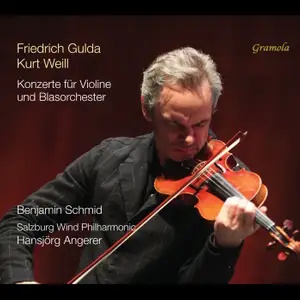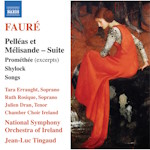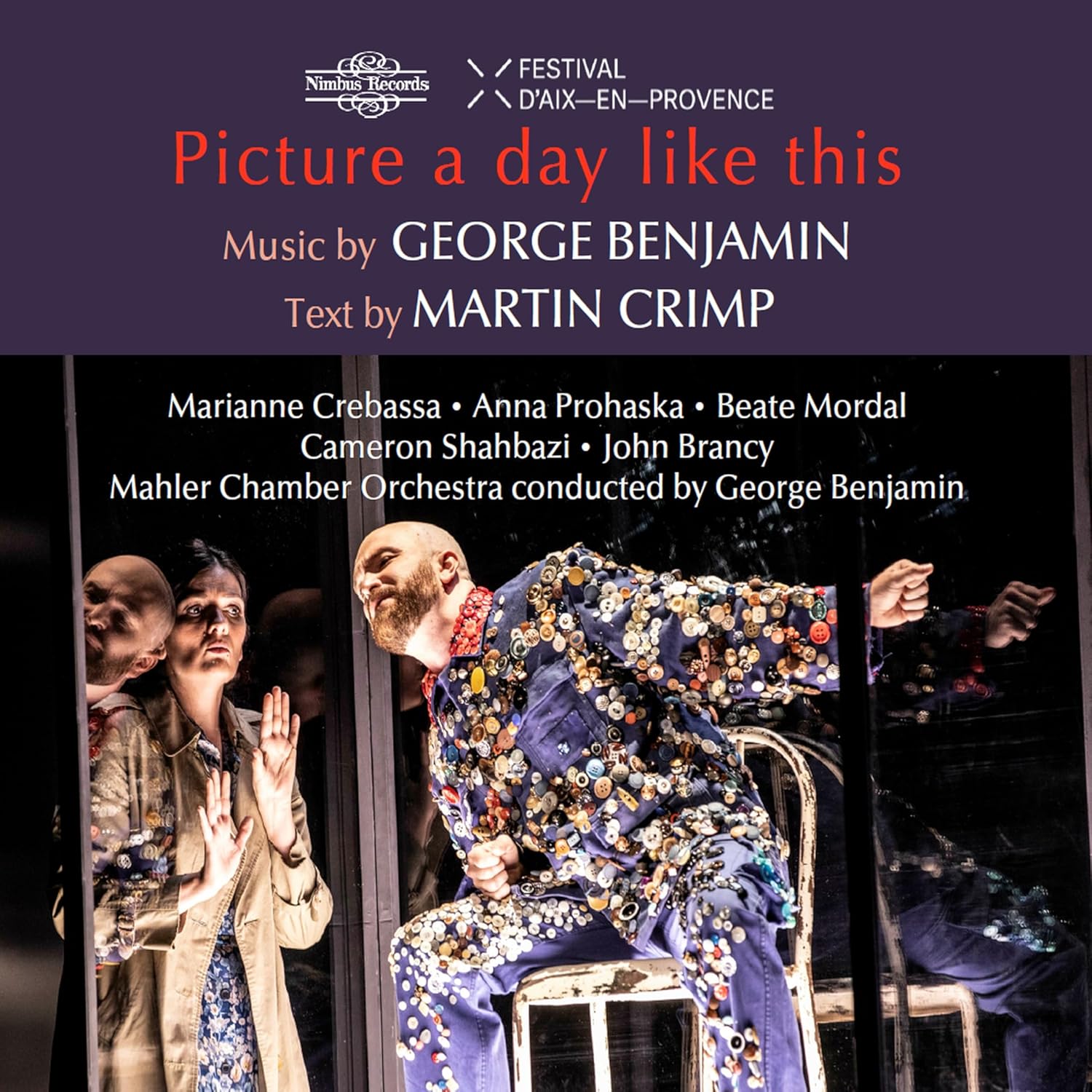
Friedrich Gulda (1930-2000)
Concerto for Cello and Wind Orchestra (version for violin) (1981)
Benjamin Schmid (b. 1968)
For Fritz for violin solo
Kurt Weill (1900-1950)
Concerto for Violin and Wind Orchestra op. 12 (1925)
Kurt Weill (1900-1950)
Youkali, Song for solo violin (arr. Benjamin Schmid)
Benjamin Schmid (violin)
Salzburg Wind Philharmonic/Hansjörg Angerer
rec. 2016, Großer Saal, Stiftung Mozarteum Salzburg, Sonic Flow Tonstudio & ORF Radiokulturhaus, Vienna Austria
Gramola 99340 [64]
Back in 2023 I reviewed another disc by Benjamin Schmid here which I enjoyed so much it received a well-deserved ‘recommended’ status. This new recording is very much a companion disc and equally fine in performance terms if somewhat quirky as regards to the music itself. I would reference that review as far as it celebrates Schmid’s remarkable playing and his assured and natural assimilation of a jazz fusion idiom on the violin.
The earlier release – which was in fact recorded after the one under consideration here – featured a concertante work by Friedrich Gulda, and his music appears here in the first recording of a version for violin of his Concerto for Cello and Wind Orchestra. This is my first encounter with the work but judging from the catalogue it has been something of a favourite amongst adventurous cellists ever since its 1981 premiere played by Heinrich Schiff – a live performance from 1988 with Schiff and Gulda can be viewed on Youtube. In fact there are multiple versions there which belies the work’s popularity. Gulda was an anti-modernist and this work makes the case for contemporary music to be attractive, indeed fun, as well as being rewarding and technically very demanding for the players. I have not made a detailed comparison between the cello original and the violin adaption so is not a question of one player’s performance over another. However, it does strike me that the violin ‘sits’ better as a lead/solo instrument in this type of piece rather than a cello.
This is a curious even eccentric hybrid work that is more suite than a concerto. In turn the nominal ‘wind orchestra’ accompaniment veers between big band pizzazz, a kind of baroquish harmonie-ensemble and an Alpine oom-pah band. Quite whether this manages to cohere together I still have no idea – but it’s quite a ride along the way. There are five movements that run just shy of 28 minutes in this performance. Each movement has a very distinct character with a central 6:15 solo cadenza a pivot point. The other four movements are titled; Ouvertüre, Idylle, Menuett and Finale alla Marcia. The instrumentation is; flute (doubling piccolo), 2 oboes, 2 clarinets, bassoon, 2 horns and 2 trumpets, trombone and tuba with a rhythm section of guitar, 2 basses – classical and jazz – and drum kit. So this too hovers between ‘straight’ and jazz/popular. The opening Ouvertüre is most explicitly the latter – a kind of jazz funk fusion with a 70’s feel right down to a Shaft-like wah pedal on the guitar. Over which Schmid riffs and dazzles. Apparently the part is nearly fully notated although there are some opportunities in the cadenza for true improvisation. As I mentioned in my previous review, to my ear Schmid is one of the few ‘classical’ players who sounds completely at home and convincing in the rock/jazz idiom too. I would add Rachel Barton-Pine and Pavel Šporcl to that elite group – many others have the technique that is required but lack the authentic feel. Gulda treats his material quite simply; this movement is just A-B-A-B-A, where A is the rock explosion and B is a gently swaying tango feel. All of it is brilliantly played by all concerned aided by Gramola giving the recording a very up close and tight acoustic which for many genres/pieces would not work but here is very effective. Quite what the relationship between rock and tango is I have no idea. But then the link to the sonorous Idyll that follows is even more tenuous. The opening sounds like a Brucknerian setting of an Austrian folk-hymn. Here the ‘B’ section is a naive Ländler which you could imagine the Von Trapps dancing to before gently reprising the Austrian hymn. As an aside – the violin again seems like a more appropriate collaborator in these faux-folk merrymakings rather than a cello but in this work trying to make sense of anything seems like a lost cause.
The central cadenza feels like much more standard contemporary fare although with a few rock/jazz gestures thrown in. Of course Schmid plays this superbly and with complete conviction. Schmid likens the fourth movement Menuett to a dance by Couperin by which he means pastiche pre-Baroque which is a fair assessment but again why I have no idea. The closing Alla Marcia is Sousa-on-steroids with the solo violin playing a manic obligato part over and above the oom-pahing orchestral group. Clearly this is hugely demanding of the soloist and Schmid rises to the challenge triumphantly. Likewise the players of the Salzburg Wind Philharmonic under Hansjörg Angerer play with style, flair and absolutely well-judged range of character across the work. I have to say that despite my unfailing admiration for the playing, my enjoyment of the work itself decreased over the times I listened to it. Simply because the first-time pleasure in the sheer dynamism and easy appeal of the music was replaced by a confusion about what it was really trying to say over the fairly extended time span.
This is pointed up all the more when heard in direct comparison to Kurt Weill’s Concerto for Violin and Wind Orchestra Op.12. The Weill is also in five movements with an accompanied cadenza placed third. The concerto was one of Weill’s breakthrough works which premiered in 1925. This was three years before the enduringly famous Threepenny Opera and after his studies with Busoni and showing the influence of a range of [then] modern composers from Hindemith to Stravinsky and even Schoenberg. Of course Weill is associated with stage and vocal music and his orchestral works represent a small part of his output. This concerto remains one of the finest examples of his instrumental art and this performance by Benjamin Schmid is as fine as any I have heard. He plays with a precision – both technical and emotional – that is ideal. The instrumentation is similar to the Gulda (and hence an intelligent coupling) with the 2nd oboe and trombone dropped and a 2nd bassoon added along with extra percussion but no rhythm section.
On Decca, Chantal Juillet played the work as part of an interesting coupling along with the Korngold and Krenek concerti in the “Entartete Musik” series. Likewise Nona Liddell made a well-regarded recording for DG with The London Sinfonietta under David Atherton. Both Juillet and Liddell are good but Schmid is even better projecting a crystalline tone and effortless performance that again is ideal for the music. What I especially enjoy is how effectively Schmid transforms his playing style from the big flamboyant gestures of the Gulda to the honed and held meticulousness of the Weill. The result is that the Gulda sounds – and probably intends to sound – like a series of affectionate period pastiches whereas the Weill is resolutely Modernist (something Gulda had little truck for).
Inserted between the two concerti and then as a little bonus after the Weill are two solo violin works written by Schmid himself. The first of these is For Fritz – for solo violin (dedicated to Fritz Kreisler and Friedrich Gulda) – which curiously the liner omits to mention at all. Schmid takes as his basis Kreisler’s own Praeludium & Allegro in the Style of Pugnani which he overlays with passages of richochet chords reminiscent of the Bach Chaconne before launching into the allegro section of that work. This is soon in turn distorted by bluesy jazz figurations. From there on the piece morphs between the two styles. In other hands this might again sound simply disjointed by Schmid plays with total authority and conviction. I imagine he plays this as a popular recital encore. The disc concludes with the 3:04 Youkali which is a kind of concert etude on Weill’s tango-habanera of the same name written as part of the incidental music to Marie Galante in 1934. Schmid’s version moves quite a long way away from the mood of the original referencing various jazz and hot-club-like licks. The ending is rather abrupt and inconclusive which makes for an odd end to this whole collection.
I always enjoy the sheer brilliance and stylishness of Benjamin Schmid’s playing and this whole disc is another tribute to his remarkable range and musicianship. He is one of those musicians who I trust to produce music and performances that always command attention and respect by the sheer quality of their playing and musicianship. However, I am not sure quite when I have liked/not liked a work as much as the Gulda. On every level it is undoubtedly brilliant and clever and witty and more often than not downright enjoyable. But then other passages seem crass and trite and not really worth the effort – despite the complete conviction and breathtaking skill of the performance here. Definitely a work that in the UK would be called a ‘marmite’ piece which should be tried before it’s “bied” [bought!]. Buyer beware …
Nick Barnard
Buying this recording via a link below generates revenue for MWI, which helps the site remain free




















